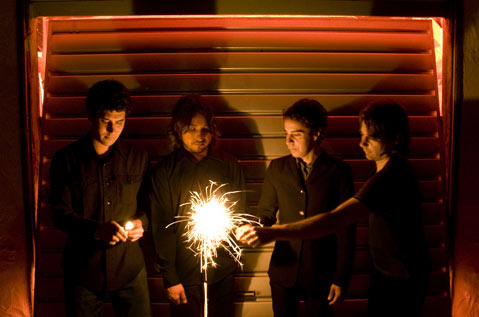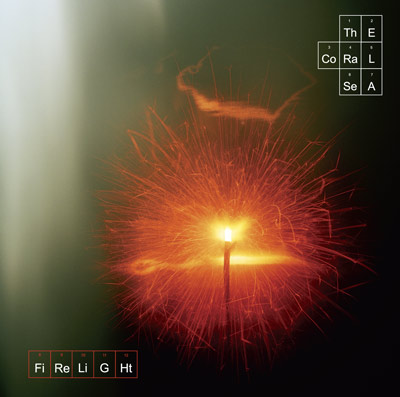New Album Finds The Coral Sea Burning Brighter Than Ever
Fire Starters

When The Coral Sea released Volcano and Heart, the S.B.-based ensemble seemingly had the world at their feet. Their sophisticated, popular sound won them a legion of admirers both in town and abroad. When label interest lured frontman Rey Villalobos to Europe at the end of 2007, it took an adventure halfway around the world to make him realize that everything he wanted was already staring him in the face. In venturing back to Santa Barbara, Villalobos consolidated the band’s lineup, wrote a collection of new songs, and turned them over to the musicians who enthusiastically went to work on making them their own. The net result is The Coral Sea’s second full-length recorded venture, Firelight, an album equal in mood to its predecessor but one of decidedly greater range. The band will offer up their new recording next Saturday, September 6, at their CD release party at Stateside prior to launching yet another global musical assault.
The new album shows quite an evolution in the band’s sound. What was the driving force behind the change? When we made Volcano and Heart, the band had just gotten together and we more or less became a band in the making of it. A few years down the line, members changed and that had a big influence on the sound. A big part of that were Austin [Beede] and his drumming. And [James] Garza changing from bass to lead guitar also had an impact, making things a little more raw and introducing a lot more passion. All of that had an impact on the band’s live sound. And when it came time to record this album I wanted to capture that.

So your live performances were the blueprint for the album? Yeah, pretty much. We recorded the whole album live, except for the vocals, as I overdubbed those. I wanted the music on this album to unfold in front of you just like it does at a show. I didn’t want it to be an album that you are sitting there listening to. I wanted it to be happening to you. And I think we got that. In listening to the album, that is pretty much how we sound live. It’s raw and honest and that’s what I wanted.
How does the songwriting typically work? Do you write specially for the band, or do the songs unfold once everyone gets their hands on them? When I wrote “Cold Eyes Down,” I was in my car parked in front of the 7-Eleven down by City College late one night, and I just started playing this song and out it came. The chorus was written in my kitchen at home and then I took it to the band and in came Garza’s wailing guitar and Eric [Ahlgren]’s melodic lines, and it just grew. I didn’t think of how they would play or anything. I just write a song and the guys come in with their parts and something beautiful happens.
What is that experience like for you? Presumably you have a certain idea for a song that must then get shuffled around a little? It’s an amazing experience. Sometimes the band’s coming from the same place I am, but other times a song goes somewhere completely different-which is the really cool thing about it.
What led you to record here in town? We just wanted to make an album with our friends. We didn’t have a huge budget that we could take to some fancy studio in Los Angeles, so we looked at what we did have. And what we had was us and our friends and a bunch of songs we had been playing for about a year. So we thought, “Let’s make the most of that and make a real honest record.” So we met up with Craig [Costigan] and Zach [Madden] at Corporate Nightmare and they got enthused about the album, which was really cool, too. That goes a long way when you are about to make a record.
Looking back over the project, what was one of the pluses of recording locally that you might not have had if you recorded in Los Angeles? Mixing and mastering. We went through so many different mixes and masterings and touchups. We were figuring on maybe one or two masters, but I think we did something like nine in the end. And if we did the album down in Los Angeles, we would never have had that luxury.
But it wasn’t just the recording of the album that is entrenched in Santa Barbara. Most of the songs were written around town, correct? I wrote them all around town because I write a lot in my car!
You actually sit in your car and write? Yeah, because it’s so intimate and quiet. I have a garden at the UCSB garden plot and I would pull my car over and write a lot up there, too. So the album was written all around Santa Barbara. I would be sitting somewhere and writing chords, or driving through town when lyrics would hit me, and then I would bring them to the band in the studio and the songs would then get fleshed out.
What happens when you’re driving? “Honeybee” is an example of that! I was driving downtown-I was on Victoria at Anacapa-and I literally had to pull over and I sang that song word for word into my tape player. It was just like, “Boom!” It just came out.
Do you keep a guitar in your car? I have my guitar with me all the time. I take it everywhere. I am at The Brewhouse right now and my guitar is sitting there in my car. I’m playing all the time. There have been times when I have sat there playing for a few hours and fallen asleep and then picked it up again when I woke up and just started playing it again.
Your guitar seems ready to hit the road. Are you and the rest of the band excited to start touring? We’re going to start with a West Coast tour. Things are harder now, what with gas prices and stuff. And we’re wanting to go across and do some shows in London this September, but again, with ticket prices the way they are it’s going to be tough. Who would have thought that world domination would come down to the cost of fuel?
4•1•1
The Coral Sea’s CD release show will be held on Saturday, September 6, at Stateside Restaurant & Lounge (1114 State St.) at 9 p.m. Ventura’s The Spires will open the show. The band’s new album, Firelight, is available for purchase online at thecoralsea.net.



